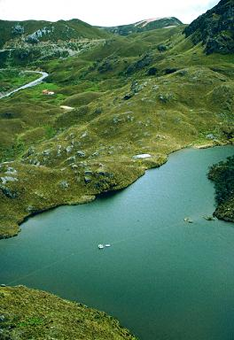NOAA/WDS Paleoclimatology - West Greenland 9,500 Year Multiproxy Lake Sediment Data
This archived Paleoclimatology Study is available from the NOAA National Centers for Environmental Information (NCEI), under the World Data Service (WDS) for Paleoclimatology. The associated NCEI study type is Lake. The data include parameters of paleolimnology with a geographic location of Greenland. The time period coverage is from 9534 to -50 in calendar years before present (BP). See metadata information for parameter and study location details. Please cite this study when using the data.
Dataset Citation
- Cite as: Perren, B.; Anderson, N.J.; Douglas, M.S.V.; Fritz, S.C. (2012-06-30): NOAA/WDS Paleoclimatology - West Greenland 9,500 Year Multiproxy Lake Sediment Data. [indicate subset used]. NOAA National Centers for Environmental Information. https://doi.org/10.25921/v15d-7q90. Accessed [date].
- Please refer to Credit tab for full citation information.
Dataset Identifiers
- doi:10.25921/v15d-7q90
- noaa-lake-13116
- NCEI DSI 1200_02
- NCEI DSI 1200_01
ISO 19115-2 Metadata
noaa-lake-13116
| Search Data |
|
| Download Data |
|
| Distribution Formats |
|
| Ordering Instructions | Contact NCEI for other distribution options and instructions. |
| Distributor |
NOAA National Centers for Environmental Information ncei.info@noaa.gov |
| Dataset Point of Contact |
NOAA National Centers for Environmental Information ncei.info@noaa.gov |
| Dataset Point of Contact | Data Center Contact NOAA World Data Service for Paleoclimatology 828-271-4800 paleo@noaa.gov |
| Coverage Description | Date Range: 9534 cal yr BP to -50 cal yr BP; |
| Time Period | -7584 to 2000 |
| Spatial Bounding Box Coordinates |
West: -52.64
East: -49.8
South: 66.86
North: 66.97
|
| Spatial Coverage Map |
| General Documentation |
|
| Associated Resources |
|
| Publication Dates |
|
| Data Presentation Form | Digital table - digital representation of facts or figures systematically displayed, especially in columns |
| Dataset Progress Status | Complete - production of the data has been completed |
| Data Update Frequency | Data update frequency not available |
| Supplemental Information | STUDY NOTES: Multiproxy Holocene sediment data from 3 lakes in west Greenland. Paleoenvironmental proxies measured include diatoms, organic content, and spectrally inferred sediment chlorophyll-a. West Greenland lake locations: SS32(Nunatak): 66.97°N, 49.80°W, 470m elevation, 21m water depth. SS16: 66.91°N, 50.46°W, 477m elevation, 12m water depth. SS49: 66.86°N, 52.64°W, 330m elevation, 10m water depth. ABSTRACT SUPPLIED BY ORIGINATOR: Holocene paleolimnological records (diatoms, organic content, spectrally inferred sediment chlorophyll-a) from three West Greenland lakes (~67°N) situated along a transect from the outer coast to a nunatak at the periphery of the Greenland Ice Sheet are used to explore the nature of regional postglacial lake development and its relationship to Holocene climate evolution. The lakes were deglaciated asynchronously by approximately 4 ka (earliest on the coast) and thus their sediment records document different starting points of Holocene ontogeny, both temporally and paleoclimatically. Despite similar time-transgressive characteristics of the diatom stratigraphies, overarching climatic factors, principally effective moisture, and eolian inputs, govern individual lake development. The transition to Neoglaciation between 5.6 and 4 ka BP marks a shift toward a cooler, moister, windier climate from the aridity and higher temperatures of the mid-Holocene (8–6 ka BP). A shift toward increased aridity, windiness, and eolian activity is documented in the interior lakes over the last 500 years. These lake records demonstrate the sensitivity of freshwater lakes in arid regions to changes in effective moisture and highlight the role of wind and eolian activity in Arctic lake environments. |
| Purpose | Records of past climate and environment derived from lake sediment records. Parameter keywords describe what was measured in this dataset. Additional summary information can be found in the abstracts of papers listed in the dataset citations. |
| Dataset Citation |
|
| Cited Authors |
|
| Originators |
|
| Publishers |
|
| Theme keywords |
Global Change Master Directory (GCMD) Science Keywords
|
| Data Center keywords |
Global Change Master Directory (GCMD) Data Center Keywords
|
| Place keywords |
|
| Use Constraints |
|
| Access Constraints |
|
| Fees |
|
Last Modified: 2024-02-22
For questions about the information on this page, please email: ncei.info@noaa.gov
For questions about the information on this page, please email: ncei.info@noaa.gov

